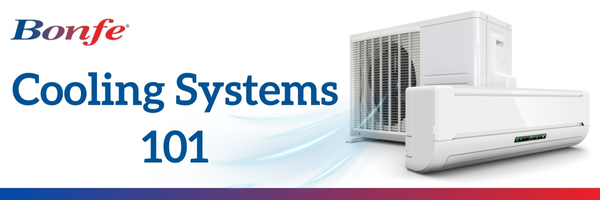
Here’s what to know before choosing a cooling
system for your home.
Is there any feeling like stepping out of the oppressive summer heat and humidity into a nice, cool home? Ahhh. Bliss.
If you don’t have that immediate sense of relief when entering your home this summer, it’s probably time to rethink your home’s cooling system. A cool, comfortable home makes a huge difference in your quality of life — allowing you to sleep better, feel better, and enjoy various potential health benefits.
We’re not making that up—an analysis of hospital patient outcomes found that the introduction of HVAC systems “resulted in a recovery effect shown by improved vital signs, reduced cardiac stress, accelerated recuperation and greater physical activity.”
Which cooling system should you choose for your home?
It can be overwhelming just thinking about the range of options available to moderate the temperature and humidity in your home. What’s the most energy-efficient cooling option? What’s the most cost-effective cooling system? What’s the most reliable cooling system?
We’re here to help. We’ve assembled a quick reference guide to home cooling systems so you can make a more informed decision. We’ll also share why now is the best time to upgrade your home’s cooling system.
Psst—in a hurry? For a quick summary of the pros and cons of each system, scroll down!
What are the different types of residential cooling systems?
When people think about residential cooling systems, central air conditioning (central A/C) is often the first option that comes to mind—but it’s not the only one. Assuming you want to go beyond the “box fans everywhere” approach to cooling your home, there are three primary methods to consider:
- Central A/C
- Heat Pump
- Ductless Mini-Split
You might be familiar with one or all of these, but it’s important to understand the capabilities and benefits of each option to determine which is the best fit for your home. Let’s quickly talk about each one—and answer the burning (no pun intended) question for our Northern friends: Do heat pumps work in Minnesota?
How central A/C units work
Is central A/C the best cooling option for your home? Let’s find out.
Unsurprisingly, central air conditioning systems are the most common type of cooling system in the U.S. Speaking of common household systems, you might be surprised to learn that a Central A/C is essentially a refrigerator’s cousin! Now that’s one cool family reunion. (Sorry!)
According to the U.S. Department of Energy, refrigerators use energy to shift unwanted heat from the inside of the refrigerator to the warmer surrounding area, like a kitchen. Air conditioners use “the same operating principles and basic components” of standard refrigerators, except the unwanted heat they’re shifting is from your home’s interior to the warmer outdoor environment. With both refrigerators and air conditioners, electricity is the standard energy source.
A central air conditioning system is connected to your home’s supply and return ducts, allowing you to moderate the temperature of the whole environment. That makes it an excellent option for dedicated, whole-home cooling in a home with ductwork.
What are heat pumps, and what are they used for?
Believe it or not, heat pumps can be used for both heating and cooling—double duty!
Heat pumps operate on a refrigeration cycle, effectively moving heat from one location to another. They’re called “heat pumps” because they’re focused on heat transfer, but as we learned in the air conditioning section, moving unwanted heat away from a space leaves the space cooler.
In colder months, a heat pump draws warmth from the outdoor air and channels it indoors to keep things toasty indoors. In warmer weather, a heat pump extracts heat from indoor spaces and disperses it outside to cool the interior. (That’s why parents often—and rightfully—respond to a door left open by saying, “I’m not paying to cool the whole outside!”)
There’s a common misconception that heat pumps aren’t relevant in colder climates like Minnesota. The truth is that heat pumps absolutely do work in Minnesota, delivering a versatile and reliable option provided they’re properly installed and maintained. Even during frigid winters, cold climate heat pumps efficiently extract heat from the outdoor air (yes, there’s warmth in cold air) to warm your home.
When the outdoor temperature drops to around 15°F or lower, the furnace automatically activates to provide supplemental heating, ensuring continuous comfort—but leveraging the heat pump for a good portion of the heating power can significantly increase the efficiency of your heating system.
What are ductless mini-splits?
If you’ve made it this far feeling frustrated and a bit left out because your home doesn’t have existing ductwork, don’t worry! We haven’t forgotten about you.
Perhaps you have ductwork in your home, but you’re only interested in cooling specific rooms. Either way, a ductless mini-split might be the right system for you.
Ductless mini-split systems use an outdoor compressor/condenser that’s connected to one or more indoor air-handling units. These units can be placed in individual rooms for targeted cooling (and heating!). Perhaps you can’t sleep without a nice, cool bedroom, but you don’t need—or your house isn’t built for—a whole-home system. A ductless mini-split system offers flexibility and a small size that appeals to many homeowners.
Which cooling system is best for your home?
The best cooling system for your home depends on several factors, including your home’s size, budget, and specific cooling needs. We know we just threw a lot of information at you, so here is a quick list featuring some of the pros and cons for each option:
Central A/C
- Pros: Cools the entire home, integrates with existing ductwork
- Cons: Can be less energy-efficient, requires ductwork, only provides cooling
Heat Pumps
- Pros: Provides both heating and cooling, energy-efficient, qualifies for substantial utility rebates and federal tax credits
- Cons: Higher upfront cost, may require supplemental heating in extreme cold
Ductless Mini-Splits
- Pros: Can provide both heating and cooling, flexible zoning, energy-efficient, no ductwork required
- Cons: Higher upfront cost, visible indoor units
Why now is the right time to upgrade your home’s cooling system
Wondering if now’s the right time to install or upgrade an A/C or other cooling system in your home? The short answer is yes! Here’s why:
- Regulation changes for refrigerants will take effect next year, leading to higher equipment costs in 2025.
- Higher-efficiency models can help lower your utility bills.
- Substantial tax credits and utility rebates are available for high-efficiency equipment (especially heat pumps). Learn more here.
Still have questions? Concerns? We’d love to talk to you and learn how we can help you make the right decision for your home and stay cool this summer and for years to come.
Schedule a free consultation with our
Home Comfort Advisors today: (612) 405-4841
Here are just a few of the reasons homeowners trust Bonfe with their cooling needs:
- Lifetime Warranty: Our repairs and installations come with our industry-leading Lifetime Warranty. This means that repair costs are covered for as long as you live in the home.
- Locally owned and operated: Located in South St. Paul, Bonfe has been proudly serving the greater Twin Cities metro since 1993.
- A+ Rating from the BBB
- 4.8 stars with over 8,500 Google Review ratings
- We’re available 24/7/365
___________________________________
[2]https://www.energy.gov/energysaver/central-air-conditioning
____________________________
JULY OFFER
MEMBERS ONLY OFFER
High-Efficiency & Rebate-Eligible HVAC Package
- This package is our most-recommended option.
- Package qualifies for up to $5,000 in utility rebates and federal tax credits.
- Includes: a high-efficiency heat pump and a 97% efficient modulating furnace, both designed for quiet operation and energy savings. Plus, a smart thermostat is included for ultimate control and comfort.
- Package is backed by our Lifetime Warranty.
- Financing options available!
Members Only Offer - Nest Thermostat + Two Nest Alarms
Giveaway rules:
- Giveaway open for entries 9/1/24-9/30/24.
- Any Membership Plan customer eligible to enter.
- Must submit entries here: https://forms.gle/374S8VDTbdRU1XSY8
- Only one submission per household.
- Chance to win 1 of 2 Nest Thermostat + Alarm Bundles
- The winners will be contacted the first week of October to arrange delivery
JUNE WINNERS

 Schedule Service
Schedule Service